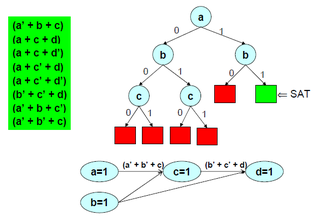
Artificial intelligence (AI) is the intelligence of machines or software, as opposed to the intelligence of humans or animals. It is also the field of study in computer science that develops and studies intelligent machines. "AI" may also refer to the machines themselves.

In artificial intelligence, symbolic artificial intelligence is the term for the collection of all methods in artificial intelligence research that are based on high-level symbolic (human-readable) representations of problems, logic and search. Symbolic AI used tools such as logic programming, production rules, semantic nets and frames, and it developed applications such as knowledge-based systems, symbolic mathematics, automated theorem provers, ontologies, the semantic web, and automated planning and scheduling systems. The Symbolic AI paradigm led to seminal ideas in search, symbolic programming languages, agents, multi-agent systems, the semantic web, and the strengths and limitations of formal knowledge and reasoning systems.

In computer science and mathematical logic, a proof assistant or interactive theorem prover is a software tool to assist with the development of formal proofs by human-machine collaboration. This involves some sort of interactive proof editor, or other interface, with which a human can guide the search for proofs, the details of which are stored in, and some steps provided by, a computer.

Robert Anthony Kowalski is an American-British logician and computer scientist, whose research is concerned with developing both human-oriented models of computing and computational models of human thinking. He has spent most of his career in the United Kingdom.
Legal informatics is an area within information science.

In logic and computer science, the Davis–Putnam–Logemann–Loveland (DPLL) algorithm is a complete, backtracking-based search algorithm for deciding the satisfiability of propositional logic formulae in conjunctive normal form, i.e. for solving the CNF-SAT problem.
In computer science, in particular in knowledge representation and reasoning and metalogic, the area of automated reasoning is dedicated to understanding different aspects of reasoning. The study of automated reasoning helps produce computer programs that allow computers to reason completely, or nearly completely, automatically. Although automated reasoning is considered a sub-field of artificial intelligence, it also has connections with theoretical computer science and philosophy.

Damien Doligez is a French academic and programmer. He is best known for his role as a developer of the OCaml system, especially its garbage collector. He is a research scientist at the French government research institution INRIA.
Franz Baader is a German computer scientist at Dresden University of Technology.

Alan Richard Bundy is a professor at the School of Informatics at the University of Edinburgh, known for his contributions to automated reasoning, especially to proof planning, the use of meta-level reasoning to guide proof search.

The following outline is provided as an overview of and topical guide to artificial intelligence:
Drew McDermott was a professor of Computer Science at Yale University. He was known for his contributions in artificial intelligence and planning.
Cryptol is a domain-specific programming language for cryptography developed by the Portland, Oregon based software development firm, Galois, Inc. The language was originally developed for use by the United States National Security Agency. The language is also used by private firms that provide information technology systems, such as the American company Rockwell Collins provides to aerospace and defense contractors in the United States.
John L. Pollock (1940–2009) was an American philosopher known for influential work in epistemology, philosophical logic, cognitive science, and artificial intelligence.

Action model learning is an area of machine learning concerned with creation and modification of software agent's knowledge about effects and preconditions of the actions that can be executed within its environment. This knowledge is usually represented in logic-based action description language and used as the input for automated planners.
Nachum Dershowitz is an Israeli computer scientist, known e.g. for the Dershowitz–Manna ordering and the multiset path ordering used to prove termination of term rewrite systems.
Christoph Walther is a German computer scientist, known for his contributions to automated theorem proving. He is Professor emeritus at Darmstadt University of Technology.

This glossary of artificial intelligence is a list of definitions of terms and concepts relevant to the study of artificial intelligence, its sub-disciplines, and related fields. Related glossaries include Glossary of computer science, Glossary of robotics, and Glossary of machine vision.
Luigia (Gigina) Carlucci Aiello is an Italian computer scientist, emeritus professor of artificial intelligence at Sapienza University of Rome.






